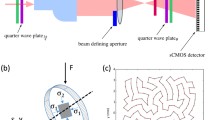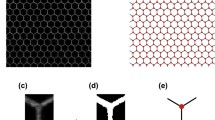Abstract
Phase-stepped photoelasticity is a powerful method for full-field stress analysis, but sequential collection of the multiple required images limits the technique to static loading applications. We have developed a system that utilizes diffraction gratings to collect four phase-stepped images simultaneously with a single camera for transient loading applications. Two adjacent, perpendicularly oriented, 1D Ronchi rulings are placed after a transparent sample to split the light into equal intensity beams for each diffraction order. The four beams that are diffracted once in the x direction and once in the y direction transmit through arrays of analyzing polariscope elements, with different combinations of fast-axis orientations for four phase-stepped images. The mirrors and imaging lenses in the system work in concert to focus each beam onto separate quadrants of the same CCD. We demonstrate the system for stress analysis of compressive loading of a Homalite-100 disk and of a Homalite-100 plate with a central hole. This system has the potential for photoelastic analysis of time-dependent materials and of dynamic events, when equipped with a high-speed camera.








Similar content being viewed by others
References
Patterson EA, Wang ZF (1998) Simultaneous observation of phase-stepped images for automated photoelasticity. J Strain Anal 33(1):1–15
Barone S, Burriesci G, Petrucci G (2002) Computer aided photoelasticity by an optimum phase stepping method. Exp Mech 42(2):132–139
Ramesh K (2000) Digital photoelsticity. Springer, New York
Yoneyama S, Kikuta H (2006) Phase-stepping photoelasticity by use of retarders with arbitrary retardation. Exp Mech 46(3):289–296
Yoneyama S, Kikuta H, Moriwaki K (2006) Simultaneous observation of phase-stepped photoelastic fringes using a pixelated microretarder array. Opt Engr 45(8):083604–1–083604–7
Kramer SLB, Mello M, Ravichandran G, Bhattacharya K (2009) Phase-shifting full-field interferometric methods for determination of in-plane tensorial stress. Exp Mech 49(2):303–315
Hobbs JW, Greene RJ, Patterson EA (2003) A novel instrument for transient photoelasticity. Exp Mech 43(4):403–409
Zhu B, Ueda K (2003) Real-time wavefront measurement based on diffraction grating holography. Opt Comm 225(1–3):1–6
Ajovalasit A, Barone S, Petrucci G, Zuccarello B (2002) The influence of the quarter wave plates in automated photoelasticity. Opt Lasers Engr 38(1–2):31–56
Tippur HV, Krishnaswamy S, Rosakis AJ (1991) A coherent gradient sensor for crack tip deformation measurements: analysis and experimental results. Int J Fract 48(3):193–204
Siegmann P, Backman D, Patterson EA (2005) A robust approach to demodulating and unwrapping phase-stepped photoelastic data. Exp Mech 45(3):278–289
Timoshenko S, Goodier JN (1951) Theory of elasticity, 2nd edn. McGraw-Hill Book Co. Inc., New York
Ramesh K, Kaslmayan T, Neethi Simon B (2011) Digital photoelasticity - a comprehensive review. J Strain Anal 46(4):245–266
Prashant PL, Ramesh K (2006) Genesis of various optical arrangements of circular polariscope in digital photoelsticity. J Aerosp Sci Technol 58(2):117–132
Goodman JW (2004) Introduction to fourier optics, 3rd edn. Roberts and Company Publishers, Greenwood Village
Acknowledgments
This work was supported by a MURI grant from the Army Research Office, grant number W911NF-07-1-0409. The authors would also like to thank the Beckman Institute for Science and Advanced Technology and the Aerospace Engineering machine shop at the University of Illinois for their assistance in this work.
Author information
Authors and Affiliations
Corresponding author
Appendix
Appendix
We conducted two types of Fourier wave-optics analysis to determine the focal length of each lens and the distance between each optic. The first is using the ideal Fourier representation of thin lenses, and the second is using the Fourier representation of thick lenses, accounting for the refractive index of the lens material for a given wavelength and curvatures. The first analysis is useful for determining approximate values for purchase of optics based on a desired magnification on the camera; this simpler analysis is provided below. The second analysis is for a specific system, and thus contains more variables than is appropriate for this paper. The reader is referred to [15] for further information on this type of analysis.
The Fourier wave-optics analysis begins with the matrix representations of coherent light, thin lenses, and propagation through free space. The matrix for coherent light at any point in space is a 2 × 1 vector with the length L from the propagation axis and angle of propagation \(\phi \) relative to the propagation axis, written as
The 2 × 2 matrix representation of a lens includes the focal length f , given by
The 2 × 2 matrix representation of light propagating a distance D in free space is given by
Coherent light originating at an object plane is considered “in focus” at the image plane when the length component, \(L_{I}\) does not depend on the angular component of the light at the object plane, \(\phi _{O}\), after propagating through the optical system. The magnification of the object at the image plane, denoted M, is defined by \(L_{I}/L_{O}\).
The analysis of the proposed system will only include the five lenses and propagation in space. The user has discretion on how to place the other optics in order to achieve the desired beam propagation and field of view. Let the distances in the system shown in Fig. 1 be represented as distance between lenses, such that \(D_{O}=d_{a}\), \(D_{1}=d_{b}+d_{c}\), \(D_{2}=d_{d}+d_{e}\), \(D_{3}=d_{f}+d_{g}+d_{h}+d_{i}\), \(D_{4}=d_{j}\), and \(D_{5}=d_{k}\). In general, the light at the image plane is represented by
As described above, the last lens is placed a distance equal to its focal length (\(D_{5}=f_{5}\)), and the first two lenses are placed a distance equal to the sum of their focal length apart (\(D_{1}=f_{1}+f_{2}\)), and therefore,
The coefficient in front of \(L_{O}\) term in \(L_{I}\) of equation (8) is \((-D_{3} + f_{3} + f_{4}) * (f_{2} f_{5}/(f_{1} f_{3} f_{4}))\); also, this coefficient is equal to M. Therefore, solving for \(D_{3}\) gives
The distance \(D_{3}\) only depends on the focal lengths of the lenses and the desired magnification. Since the coefficient in front of \(\phi _{O}\) in \(L_{I}\) must be equal to zero for the image to be in focus, then substituting equation (9) into (8) results in the following equation:
Solving for \(D_{2}\) gives
The distance \(D_{2}\) depends on the focal lengths of the lenses, the desired magnification, and the distance between the object and the first lens. Substituting both equations (9) and (11) into equation (8) results in \(L_{I} = M L_{O}\), implying that the image is in focus regardless of distance \(D_{4}\).
Rights and permissions
About this article
Cite this article
Kramer, S.L.B., Beiermann, B.A., White, S.R. et al. Simultaneous Observation of Phase-Stepped Images for Photoelasticity Using Diffraction Gratings. Exp Mech 53, 1343–1355 (2013). https://doi.org/10.1007/s11340-013-9747-0
Received:
Accepted:
Published:
Issue Date:
DOI: https://doi.org/10.1007/s11340-013-9747-0




